The MRI-based quantitative biomarkers market is projected to grow from USD 326.5 million in 2025 to approximately USD 536.9 million by 2035, recording an absolute increase of USD 210.4 million over the forecast period. This translates into a total growth of 64.4%, with the market forecast to expand at a compound annual growth rate (CAGR) of 5.1% between 2025 and 2035. The overall market size is expected to grow by nearly 1.6X during the same period, supported by increasing demand for precision medicine technologies, growing adoption of quantitative imaging techniques, and rising utilization of AI-powered diagnostic solutions across global healthcare and clinical research sectors.
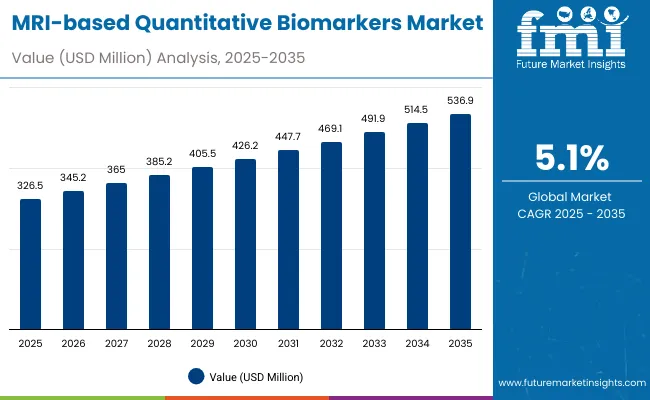
MRI-based Quantitative Biomarkers Market Key Takeaways
| Metric | Value |
|---|---|
| Estimated Value in (2025E) | USD 326.5 million |
| Forecast Value in (2035F) | USD 536.9 million |
| Forecast CAGR (2025 to 2035) | 5.1% |
Between 2025 and 2030, the MRI-based quantitative biomarkers market is projected to expand from USD 326.5 million to USD 426.2 million, resulting in a value increase of USD 99.7 million, which represents 47.4% of the total forecast growth for the decade. This phase of development will be shaped by increasing precision medicine adoption, rising demand for quantitative imaging biomarkers, and growing utilization in clinical trial applications. Medical imaging technology manufacturers and biomarker specialists are expanding their AI integration capabilities to address the growing preference for automated quantitative analysis features in diagnostic imaging systems.
From 2030 to 2035, the market is forecast to grow from USD 426.2 million to USD 536.9 million, adding another USD 110.7 million, which constitutes 52.6% of the overall ten-year expansion. This period is expected to be characterized by the expansion of advanced quantitative imaging technologies, the integration of machine learning algorithms for enhanced biomarker analysis, and the development of specialized applications for personalized medicine. The growing emphasis on early disease detection and treatment monitoring will drive demand for sophisticated MRI-based quantitative biomarkers with enhanced accuracy capabilities and improved diagnostic precision.
Between 2020 and 2024, the MRI-based quantitative biomarkers market experienced steady growth, driven by increasing medical imaging technology investments and growing recognition of quantitative biomarkers' superior diagnostic capabilities across clinical research and healthcare applications. The market developed as healthcare providers recognized the potential for AI-powered quantitative analysis to enhance diagnostic accuracy while meeting modern precision medicine requirements for objective measurement standards. Technological advancement in imaging software and biomarker validation began emphasizing the critical importance of maintaining measurement precision while extending diagnostic capabilities and improving patient outcome prediction effectiveness.
The MRI-based quantitative biomarkers market represents a rapidly emerging precision medicine opportunity at the intersection of medical imaging technology, artificial intelligence, and quantitative analysis, with the market projected to expand from USD 326.5 million in 2025 to USD 536.9 million by 2035 at a steady 5.1% CAGR-a 1.6X growth driven by accelerating precision medicine adoption, healthcare provider demand for objective diagnostic tools, and the integration of AI-powered quantitative analysis into routine clinical practice.
This convergence opportunity leverages the ubiquity of MRI imaging, the demand for personalized medicine approaches, and advances in computational analysis to create solutions that offer objective, quantitative measurements in traditionally subjective diagnostic assessments. Metabolic biomarkers lead with 23.0% market share due to their clinical utility in metabolic disorders and treatment monitoring, while diagnostic imaging centers dominate demand as healthcare facilities increasingly invest in advanced imaging capabilities. Geographic growth is strongest in India (7.6% CAGR) and China (6.9% CAGR), where healthcare modernization and medical imaging infrastructure development create ideal market conditions.
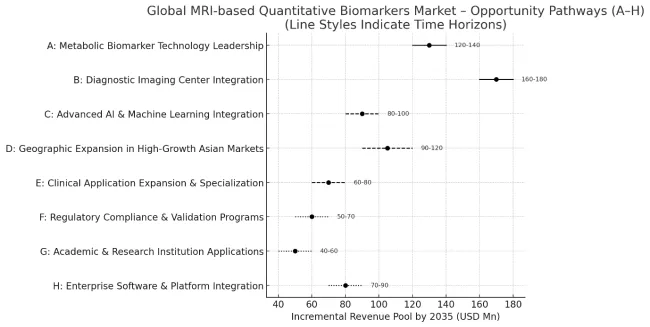
Pathway A - Metabolic Biomarker Technology Leadership. The dominant biomarker type offers superior clinical utility, established validation pathways, and proven diagnostic value essential for precision medicine applications. Companies developing advanced metabolic quantification algorithms with enhanced accuracy, standardized measurement protocols, and regulatory compliance capabilities will capture the leading technology segment. Expected revenue pool: USD 120-140 million.
Pathway B - Diagnostic Imaging Center Integration. The largest end-user segment benefits from growing healthcare provider investment in advanced imaging technologies and precision diagnostic capabilities. Providers developing comprehensive diagnostic solutions with seamless workflow integration, automated analysis features, and clinical decision support tools will dominate this primary market. Opportunity: USD 160-180 million.
Pathway C - Advanced AI and Machine Learning Integration. Next-generation products require sophisticated artificial intelligence capable of automated analysis, pattern recognition, and predictive modeling. Companies investing in deep learning algorithms, computer vision technologies, and clinical validation studies will create competitive differentiation and premium positioning. Revenue uplift: USD 80-100 million.
Pathway D - Geographic Expansion in High-Growth Asian Markets. India and China's rapid healthcare modernization and growing medical imaging adoption create substantial opportunities. Local partnerships, regulatory compliance strategies, and cost-effective implementation approaches enable market penetration in these high-growth regions. Pool: USD 90-120 million.
Pathway E - Clinical Application Expansion and Specialization. Modern healthcare demands specialized biomarkers for specific disease areas and treatment monitoring applications. Developing products with disease-specific algorithms, treatment response assessment capabilities, and longitudinal monitoring features addresses growing specialty medicine demands while improving patient outcomes. Expected upside: USD 60-80 million.
Pathway F - Regulatory Compliance and Validation Programs. Advanced products require comprehensive regulatory approval, clinical validation, and quality assurance systems. Solutions offering FDA clearance pathways, CE marking compliance, and robust clinical evidence packages create enhanced value propositions and market access advantages. USD 50-70 million.
Pathway G - Academic and Research Institution Applications. Universities and research centers represent growing opportunities for advanced quantitative analysis, clinical trial support, and biomarker discovery research. Developing specialized solutions for research applications, grant funding support, and collaborative research programs expands beyond clinical markets. Pool: USD 40-60 million.
Pathway H - Enterprise Software and Platform Integration. Healthcare systems demand comprehensive platforms that integrate with existing imaging infrastructure, electronic health records, and clinical workflows. Companies developing enterprise-grade solutions with comprehensive connectivity, scalability features, and healthcare IT integration will capture premium market segments. Expected revenue: USD 70-90 million.
Market expansion is being supported by the increasing global demand for precision medicine solutions and the corresponding shift toward AI-powered diagnostic technologies that can provide superior measurement accuracy while meeting healthcare requirements for objective and quantitative clinical assessments.
Modern healthcare providers and research institutions are increasingly focused on incorporating MRI-based quantitative biomarkers to enhance diagnostic precision while satisfying demands for evidence-based medicine and standardized measurement protocols. MRI-based quantitative biomarkers' proven ability to deliver superior diagnostic accuracy, objective measurements, and reproducible results makes them essential tools for precision medicine applications and clinical research studies.
The growing emphasis on personalized medicine and objective diagnostic assessment is driving demand for high-quality MRI-based quantitative biomarker products that can support distinctive clinical applications and premium healthcare positioning across diagnostic imaging, clinical research, and pharmaceutical development categories.
Healthcare provider preference for technologies that combine imaging excellence with advanced quantitative capabilities is creating opportunities for innovative AI-powered implementations in both established and emerging precision medicine applications. The rising influence of artificial intelligence technologies and automated analysis systems is also contributing to increased adoption of premium MRI-based quantitative biomarker products that can provide authentic precision medicine integration characteristics.
The market is segmented by biomarker type, application, end users, and region. The demand for biomarker type is divided into metabolic, tissue microstructure, relaxometry, perfusion/vascular, susceptibility, structural, functional, and others. Based on application, the market is categorized into neurology, oncology, cardiology, hepatology, musculoskeletal, and other applications. Based on end users, the market is segmented into diagnostic imaging centers, hospitals, specialty clinics, ambulatory surgical centers, academics & research institutes, and others. Regionally, the market is divided into North America, Europe, East Asia, South Asia & Pacific, Latin America, and the Middle East & Africa.
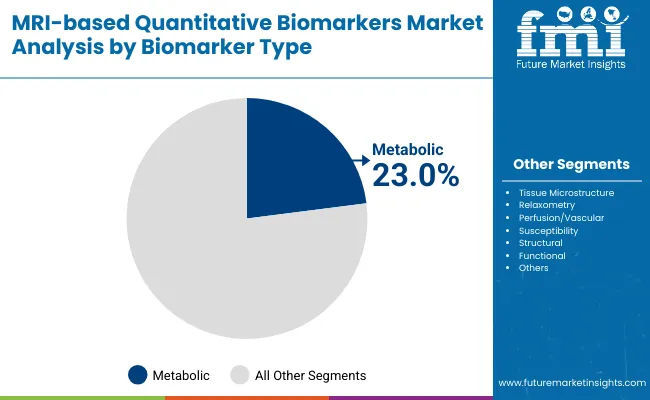
The metabolic biomarker segment is projected to account for 23.0% of the MRI-based quantitative biomarkers market in 2025, reaffirming its position as the leading biomarker type category. Medical imaging manufacturers and diagnostic technology producers increasingly utilize metabolic biomarkers for their superior clinical utility, established validation pathways, and ease of integration in precision medicine applications across diverse healthcare installations. Metabolic biomarker technology's standardized measurement protocols and proven diagnostic value directly address the clinical requirements for objective assessment and reproducible measurements in quantitative imaging operations.
This biomarker segment forms the foundation of modern precision medicine applications, as it represents the technology with the greatest clinical validation potential and established compatibility across multiple imaging platforms and clinical workflows. Manufacturer investments in metabolic biomarker optimization and clinical validation continue to strengthen adoption among medical imaging equipment producers. With healthcare providers prioritizing objective measurements and evidence-based diagnostics, metabolic biomarker systems align with both clinical utility objectives and diagnostic accuracy requirements, making them the central component of comprehensive quantitative imaging strategies.
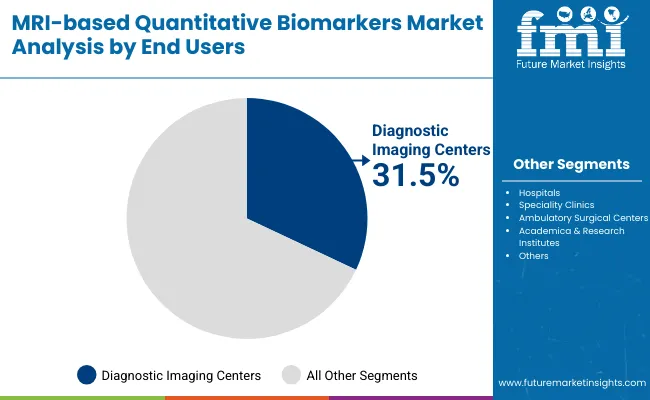
Diagnostic imaging centers are projected to represent the largest share of MRI-based quantitative biomarkers demand in 2025 at 31.5%, underscoring their critical role as the primary end-user for advanced imaging technologies in specialized diagnostic facilities and outpatient imaging operations. Healthcare administrators and imaging center operators prefer MRI-based quantitative biomarkers for their exceptional diagnostic capabilities, workflow integration features, and ability to maintain consistent quality standards while supporting modern precision medicine requirements during diagnostic imaging procedures. Positioned as essential tools for high-performance diagnostic imaging operations, MRI-based quantitative biomarkers offer both technological advancement and operational efficiency advantages.
The segment is supported by continuous growth in outpatient imaging demand and the growing availability of advanced quantitative analysis technologies that enable enhanced diagnostic capabilities and improved patient throughput at the diagnostic center level. Additionally, imaging centers are investing in premium diagnostic technologies to support competitive differentiation and specialized service offerings. As precision medicine adoption continues to expand and healthcare providers seek superior diagnostic solutions, diagnostic imaging centers will continue to dominate the end-user landscape while supporting technology advancement and clinical excellence optimization strategies.
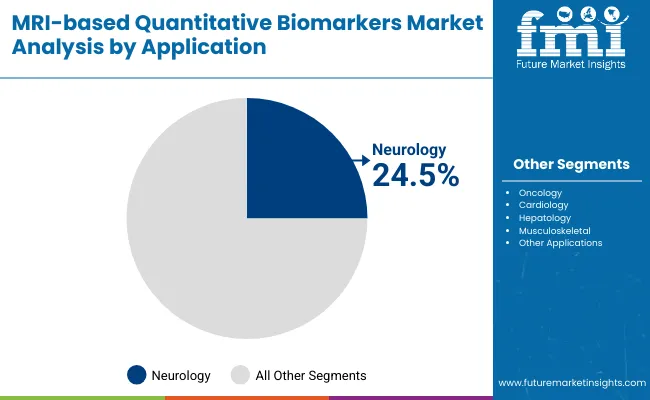
The neurology application segment is projected to account for 24.5% of the MRI-based quantitative biomarkers market in 2025, reaffirming its position as the leading application category. Medical imaging specialists and neurological research institutions increasingly utilize MRI-based quantitative biomarkers for their superior diagnostic capabilities in neurological disorders, brain imaging applications, and neurodegenerative disease monitoring across diverse clinical installations. Neurology application technology's established clinical protocols and proven diagnostic value directly address the medical requirements for objective neurological assessment and reproducible measurements in brain imaging operations.
This application segment forms the foundation of modern neurological diagnostics, as it represents the specialty with the greatest clinical validation potential and established compatibility across multiple neuroimaging platforms and clinical workflows. Healthcare investments in neurological biomarker optimization and clinical validation continue to strengthen adoption among medical imaging specialists. With healthcare providers prioritizing early detection of neurological conditions and treatment monitoring capabilities, neurology applications align with both clinical utility objectives and patient care requirements, making them the central component of comprehensive quantitative neuroimaging strategies.
The MRI-based quantitative biomarkers market is advancing steadily due to increasing precision medicine adoption and growing demand for objective diagnostic solutions that emphasize superior measurement accuracy across clinical research and healthcare applications. However, the market faces challenges, including high implementation costs compared to conventional imaging analysis, technical complexity in quantitative algorithm development, and competition from alternative diagnostic technologies. Innovation in artificial intelligence integration and clinical validation continues to influence market development and expansion patterns.
Expansion of Advanced Precision Medicine Applications
The growing adoption of MRI-based quantitative biomarkers in comprehensive precision medicine programs and clinical research applications is enabling healthcare providers to develop solutions that provide distinctive diagnostic capabilities while commanding premium positioning and enhanced clinical value characteristics. Advanced applications provide superior measurement accuracy while allowing more sophisticated clinical assessment across various medical specialties and research segments. Healthcare providers are increasingly recognizing the competitive advantages of quantitative biomarker positioning for premium service development and precision medicine market penetration.
Integration of Artificial Intelligence and Machine Learning Programs
Modern MRI-based quantitative biomarker suppliers are incorporating advanced AI algorithms, automated analysis systems, and machine learning technologies to enhance diagnostic accuracy, improve measurement consistency, and meet healthcare demands for efficient and reliable quantitative analysis solutions. These programs improve product performance while enabling new applications, including predictive analytics and personalized treatment monitoring systems. Advanced AI integration also allows suppliers to support premium market positioning and technology leadership beyond traditional quantitative imaging products.
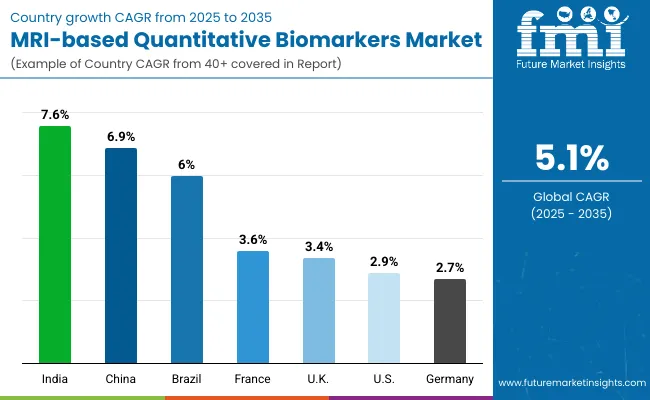
| Country | CAGR (2025 to 2035) |
|---|---|
| India | 7.6% |
| China | 6.9% |
| Brazil | 6.0% |
| France | 3.6% |
| UK | 3.4% |
| USA | 2.9% |
| Germany | 2.7% |
The MRI-based quantitative biomarkers market is experiencing steady growth globally, with India leading at a 7.6% CAGR through 2035, driven by the rapidly expanding healthcare infrastructure sector, significant investments in medical technology modernization, and increasing adoption of precision medicine systems. China follows at 6.9%, supported by growing healthcare technology demand, rising medical imaging investments, and expanding clinical research activities. Brazil shows growth at 6.0%, emphasizing healthcare infrastructure development and medical technology advancement.
France records 3.6%, focusing on established medical research applications and precision medicine development. The UK demonstrates 3.4% growth, prioritizing National Health Service modernization and advanced diagnostic technology innovation. The USA exhibits 2.9% growth, supported by established healthcare technology infrastructure and mature precision medicine adoption. Germany shows 2.7% growth, emphasizing precision manufacturing excellence and high-quality medical technology product development.
The report covers an in-depth analysis of 40+ countries; seven top-performing countries are highlighted below.
Revenue from MRI-based quantitative biomarkers in India is projected to exhibit exceptional growth with a CAGR of 7.6% through 2035, driven by the rapidly expanding healthcare infrastructure sector and significant government investments in medical technology modernization across major urban centers. The country's growing healthcare services market and increasing adoption of precision medicine technologies are creating substantial demand for quantitative imaging solutions in both public and private healthcare applications. Major healthcare technology manufacturers and medical imaging companies are establishing comprehensive research and distribution capabilities to serve both domestic consumption and regional export markets.
Revenue from MRI-based quantitative biomarkers in China is expanding at a CAGR of 6.9%, supported by growing healthcare technology demand, increasing medical imaging investments, and expanding clinical research infrastructure with modern diagnostic capabilities. The country's developing precision medicine ecosystem and expanding healthcare technology infrastructure are driving demand for advanced quantitative analysis products across both urban healthcare facilities and research institutions. International medical technology companies and domestic healthcare manufacturers are establishing comprehensive manufacturing and distribution capabilities to address growing market demand for precision diagnostic solutions.
Revenue from MRI-based quantitative biomarkers in Brazil is projected to grow at a CAGR of 6.0% through 2035, supported by the country's expanding healthcare infrastructure sector, growing medical technology applications, and increasing adoption of modern diagnostic technologies requiring quantitative analysis solutions. Brazilian healthcare providers and medical research institutions consistently seek innovative diagnostic technologies that enhance clinical capabilities for both healthcare delivery applications and medical research markets. The country's position as a regional healthcare hub continues to drive innovation in medical technology applications and clinical standards.
Revenue from MRI-based quantitative biomarkers in France is projected to grow at a CAGR of 3.6% through 2035, driven by the country's established medical research sector, precision medicine development capabilities, and leadership in clinical technology applications. France's sophisticated healthcare culture and willingness to invest in high-performance medical technologies are creating steady demand for both standard and premium MRI-based quantitative biomarker varieties. Leading medical technology companies and healthcare institutions are establishing comprehensive research strategies to serve both European markets and growing international demand.
Revenue from MRI-based quantitative biomarkers in the United Kingdom is projected to grow at a CAGR of 3.4% through 2035, supported by the country's National Health Service modernization programs, innovation leadership capabilities, and established market for advanced medical technologies. British healthcare providers and medical technology manufacturers prioritize innovation, clinical effectiveness, and evidence-based medicine, making MRI-based quantitative biomarkers essential tools for both healthcare system upgrades and medical research projects. The country's comprehensive healthcare ecosystem and clinical adoption patterns support continued market development.
Revenue from MRI-based quantitative biomarkers in the United States is projected to grow at a CAGR of 2.9% through 2035, supported by the country's established healthcare technology sector, mature precision medicine adoption, and comprehensive medical research infrastructure. American healthcare providers' focus on clinical innovation, diagnostic accuracy, and patient outcomes creates steady demand for quantitative biomarker products. The country's advanced healthcare technology ecosystem and established adoption patterns drive consistent utilization across both traditional healthcare facilities and emerging precision medicine applications.
Revenue from MRI-based quantitative biomarkers in Germany is projected to grow at a CAGR of 2.7% through 2035, supported by the country's precision manufacturing excellence, advanced medical technology expertise, and established reputation for producing superior healthcare technology products while working to enhance AI integration capabilities and develop next-generation quantitative analysis technologies. Germany's medical technology industry continues to benefit from its reputation for producing high-quality medical devices while focusing on innovation and manufacturing precision.
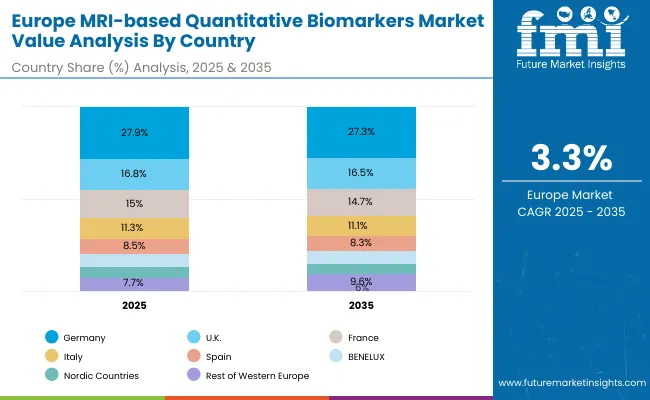
The MRI-based quantitative biomarkers market in Europe is projected to grow at a CAGR of 3.3% from 2025 to 2035. Germany is expected to maintain its leadership position with a 27.9% market share in 2025, declining slightly to 27.3% by 2035, supported by its precision medical imaging technologies, advanced healthcare infrastructure, and role as a regional R&D hub.
The United Kingdom follows with a 16.8% share in 2025, projected to reach 16.5% by 2035, driven by priorities in advanced diagnostic imaging, clinical excellence, and integration of quantitative biomarkers in patient monitoring. France holds a 15.0% share in 2025, expected to moderate to 14.7% by 2035, reflecting steady adoption of imaging biomarkers, though constrained by regulatory complexity and competitive market dynamics.
Italy accounts for 11.3% in 2025, projected to ease to 11.1% by 2035, supported by strong adoption in oncology and neurology applications. Spain contributes 8.5% in 2025, declining marginally to 8.3% by 2035, reflecting competitive pressures and resource allocation challenges across public healthcare systems.
The Nordic Countries represent 7.7% in 2025, forecasted to expand to 9.6% by 2035, benefitting from advanced healthcare systems, technology-driven clinical adoption, and government support for precision diagnostics. BENELUX holds 6.3% in 2025, expected to remain stable at 6.3% by 2035, while the Rest of Western Europe region is projected at 7.6% in 2025, declining to 6.0% by 2035, reflecting mixed growth dynamics across smaller and mature markets.
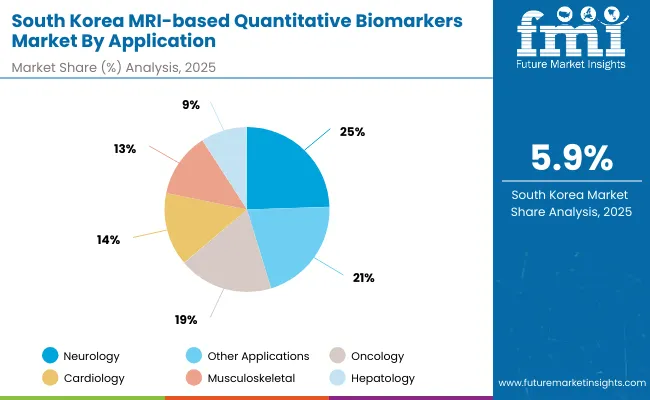
The MRI-based quantitative biomarkers market in South Korea is projected to expand steadily from 2025 to 2035, supported by strong imaging infrastructure, adoption of advanced diagnostic protocols, and emphasis on precision medicine.
Neurology is expected to maintain its leadership with a 25.0% market share in 2025, projected at 24.8% by 2035, driven by the prevalence of neurodegenerative disorders and demand for early disease detection. Other applications follow with 21.0% in 2025, anticipated to reach 21.2% by 2035, supported by cross-specialty imaging demand.
Oncology accounts for 19.0% in 2025, projected at 19.3% by 2035, driven by rising cancer screening and personalized treatment planning. Cardiology represents 14.0% in 2025, expected to sustain 14.1% by 2035, benefiting from cardiac MRI adoption in arrhythmia and ischemic heart disease management. Musculoskeletal applications contribute 13.0% in 2025, projected at 13.1% by 2035, while hepatology holds 9.0% in 2025, expected to remain steady at 9.0% by 2035, reflecting stable but limited demand.
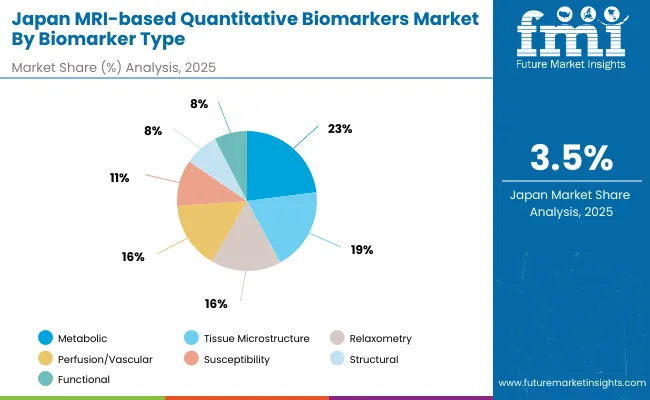
The MRI-based quantitative biomarkers market in Japan is projected to grow through 2035, supported by advancements in imaging technologies, precision diagnostics, and integration of biomarkers in clinical decision-making.
Metabolic biomarkers are expected to maintain their leadership with a 23.0% market share in 2025, projected at 22.8% by 2035, reflecting growing use in oncology and metabolic disease research. Tissue microstructure follows with 19.0% in 2025, expected to sustain 19.1% by 2035, supported by adoption in neurology and musculoskeletal imaging.
Susceptibility biomarkers hold 16.0% in 2025, projected at 16.1% by 2035, driven by applications in stroke and neurovascular imaging. Perfusion/vascular biomarkers also account for 16.0% in 2025, forecasted to remain stable at 16.0% by 2035, supported by cardiovascular and tumor blood flow studies.
Relaxometry biomarkers represent 11.0% in 2025, expected to hold 11.0% by 2035, while structural biomarkers account for 8.0% in 2025, projected to remain steady at 8.0% by 2035, reflecting niche but consistent adoption in clinical and research applications.
The MRI-based quantitative biomarkers market is characterized by competition among established medical imaging technology companies, specialized quantitative analysis software developers, and integrated healthcare technology suppliers. Companies are investing in advanced artificial intelligence algorithms, clinical validation programs, application-specific product development, and comprehensive healthcare workflow integration capabilities to deliver consistent, high-performance, and reliable quantitative biomarker products. Innovation in AI-powered analysis enhancement, clinical evidence generation, and customized healthcare system compatibility is central to strengthening market position and clinical adoption.
CaliberMRI leads the market with a strong focus on quantitative imaging innovation and comprehensive analysis solutions, offering advanced MRI-based quantitative biomarker products with emphasis on clinical accuracy and technology integration excellence. Olea Medical provides integrated medical imaging software capabilities with a focus on advanced visualization and global healthcare distribution networks. Biosyn delivers specialized biomarker analysis technology with a focus on precision medicine applications and clinical research leadership.
Invitae specializes in genetic testing and precision medicine with an emphasis on AI integration and clinical decision support. VIDA Diagnostics focuses on pulmonary imaging solutions and advanced quantitative analysis technologies. Synthetic MR emphasizes synthetic imaging and automated analysis expertise with a focus on workflow optimization and clinical efficiency.
| Items | Values |
|---|---|
| Quantitative Units (2025) | USD million |
| Biomarker Type | Metabolic, Tissue Microstructure, Relaxometry, Perfusion/Vascular, Susceptibility, Structural, Functional, Others |
| Application | Neurology, Oncology, Cardiology, Hepatology, Musculoskeletal, Other Applications |
| End Users | Diagnostic Imaging Centers, Hospitals, Specialty Clinics, Ambulatory Surgical Centers, Academics & Research Institutes, Others |
| Regions Covered | North America, Europe, East Asia, South Asia & Pacific, Latin America, Middle East & Africa |
| Countries Covered | United States, Canada, United Kingdom, Germany, France, China, Japan, South Korea, India, Brazil, Australia and 40+ countries |
| Key Companies Profiled | CaliberMRI, Olea Medical, Biosyn, Invitae, VIDA Diagnostics, Synthetic MR, and Imbio |
| Additional Attributes | Dollar sales by biomarker type, application, and end users, regional demand trends, competitive landscape, technological advancements in AI-powered analysis, clinical validation initiatives, healthcare workflow integration programs, and precision medicine optimization strategies |
By North America
By Europe
By East Asia
By South Asia & Pacific
By Latin America
By Middle East & Africa
The global MRI-based quantitative biomarkers market is valued at USD 326.5 million in 2025.
The size for the MRI-based quantitative biomarkers market is projected to reach USD 536.9 million by 2035.
The MRI-based quantitative biomarkers market is expected to grow at a 5.1% CAGR between 2025 and 2035.
The key biomarker type segments in the MRI-based quantitative biomarkers market are metabolic, tissue microstructure, relaxometry, perfusion/vascular, susceptibility, structural, functional, and others.
In terms of end users, diagnostic imaging centers segment is set to command 31.5% share in the MRI-based quantitative biomarkers market in 2025.






Our Research Products

The "Full Research Suite" delivers actionable market intel, deep dives on markets or technologies, so clients act faster, cut risk, and unlock growth.

The Leaderboard benchmarks and ranks top vendors, classifying them as Established Leaders, Leading Challengers, or Disruptors & Challengers.

Locates where complements amplify value and substitutes erode it, forecasting net impact by horizon

We deliver granular, decision-grade intel: market sizing, 5-year forecasts, pricing, adoption, usage, revenue, and operational KPIs—plus competitor tracking, regulation, and value chains—across 60 countries broadly.

Spot the shifts before they hit your P&L. We track inflection points, adoption curves, pricing moves, and ecosystem plays to show where demand is heading, why it is changing, and what to do next across high-growth markets and disruptive tech

Real-time reads of user behavior. We track shifting priorities, perceptions of today’s and next-gen services, and provider experience, then pace how fast tech moves from trial to adoption, blending buyer, consumer, and channel inputs with social signals (#WhySwitch, #UX).

Partner with our analyst team to build a custom report designed around your business priorities. From analysing market trends to assessing competitors or crafting bespoke datasets, we tailor insights to your needs.
Supplier Intelligence
Discovery & Profiling
Capacity & Footprint
Performance & Risk
Compliance & Governance
Commercial Readiness
Who Supplies Whom
Scorecards & Shortlists
Playbooks & Docs
Category Intelligence
Definition & Scope
Demand & Use Cases
Cost Drivers
Market Structure
Supply Chain Map
Trade & Policy
Operating Norms
Deliverables
Buyer Intelligence
Account Basics
Spend & Scope
Procurement Model
Vendor Requirements
Terms & Policies
Entry Strategy
Pain Points & Triggers
Outputs
Pricing Analysis
Benchmarks
Trends
Should-Cost
Indexation
Landed Cost
Commercial Terms
Deliverables
Brand Analysis
Positioning & Value Prop
Share & Presence
Customer Evidence
Go-to-Market
Digital & Reputation
Compliance & Trust
KPIs & Gaps
Outputs
Full Research Suite comprises of:
Market outlook & trends analysis
Interviews & case studies
Strategic recommendations
Vendor profiles & capabilities analysis
5-year forecasts
8 regions and 60+ country-level data splits
Market segment data splits
12 months of continuous data updates
DELIVERED AS:
PDF EXCEL ONLINE
Quantitative Casting Furnace Market Size and Share Forecast Outlook 2025 to 2035
Quantitative Pathology Imaging Market Analysis - Size and Share Forecast Outlook 2025 to 2035
EPO Biomarkers Market Size and Share Forecast Outlook 2025 to 2035
Vitamin Biomarkers Market Size and Share Forecast Outlook 2025 to 2035
Molecular Biomarkers For Cancer Detection Market Size and Share Forecast Outlook 2025 to 2035
Prognostic Biomarkers Market
Neurological Biomarkers Market Size and Share Forecast Outlook 2025 to 2035
Predisposition Biomarkers Market Size and Share Forecast Outlook 2025 to 2035
Asthma and COPD Biomarkers Market
Diagnostic Exosome Biomarkers Market Trends – Growth & Forecast 2025 to 2035
Cognitive Impairment Biomarkers Market Size and Share Forecast Outlook 2025 to 2035

Thank you!
You will receive an email from our Business Development Manager. Please be sure to check your SPAM/JUNK folder too.
Chat With
MaRIA